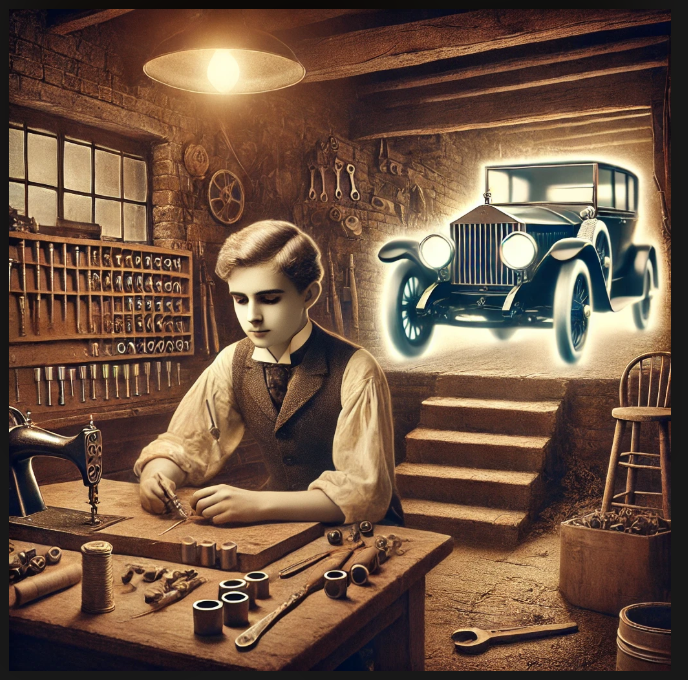
History of Rolls Royce
Rolls-Royce, the epitome of luxury and engineering excellence, was founded in 1906 by Charles Rolls and Henry Royce. Their partnership began in 1904, when Royce, a self-taught engineer, impressed Rolls, a passionate automobile dealer, with his reliable and well-crafted two-cylinder car.
The company’s first major success came with the Silver Ghost in 1907, earning the title “The Best Car in the World” for its unmatched reliability and performance. This marked the beginning of Rolls-Royce’s legacy in the luxury automobile market.
During World War I, Rolls-Royce expanded into aviation, producing the Eagle engine, which powered Allied aircraft. This diversification into aerospace engineering continued through World War II, with the iconic Merlin engine playing a pivotal role in the success of the Spitfire and Hurricane fighter planes.
After the war, Rolls-Royce cemented its status as a global leader in both automotive and aerospace industries. The Spirit of Ecstasy, introduced in 1911, became a hallmark of the brand, symbolizing elegance and luxury.
In 1998, BMW acquired Rolls-Royce Motor Cars, ushering in a new era. The brand retained its commitment to craftsmanship and innovation while incorporating modern technologies, such as electric vehicles like the Rolls-Royce Spectre.
Today, Rolls-Royce remains a symbol of prestige, blending heritage with cutting-edge advancements. Its journey from a modest beginning to global acclaim is a testament to the vision of its founders and the enduring pursuit of excellence.
History of the Rolls-Royce Logo
The Rolls-Royce logo is an enduring symbol of luxury, engineering excellence, and sophistication. It comprises two key elements: the intertwined “RR” monogram and the iconic Spirit of Ecstasy mascot.
The “RR” Monogram
The interlocking “RR” in the logo stands for the initials of the founders, Charles Rolls and Henry Royce. This emblem represents their partnership, uniting Rolls’ passion for automobiles and Royce’s engineering expertise. The logo was designed in 1904 when their collaboration began.
Initially, the “RR” was in red, symbolizing passion and energy. However, in 1933, following the death of Henry Royce, the logo’s color was changed to black to signify mourning. The change also gave the emblem a timeless and sophisticated appearance, reflecting the brand’s growing status.
The Spirit of Ecstasy
The Spirit of Ecstasy, also known as the “Flying Lady,” was introduced in 1911 as the official mascot of Rolls-Royce cars. Designed by British sculptor Charles Sykes, it was inspired by Eleanor Thornton, a model and secretary rumored to have been romantically involved with car enthusiast Lord Montagu of Beaulieu.
The figurine depicts a woman leaning forward with her arms outstretched behind her, resembling wings. It symbolizes grace, elegance, and speed, perfectly complementing the brand’s image.
Over the years, the Spirit of Ecstasy has been slightly modified to suit modern designs, including a retractable version introduced for safety and aerodynamics.
Modern Significance
The Rolls-Royce logo and Spirit of Ecstasy remain central to the brand’s identity, embodying its commitment to luxury, innovation, and timeless craftsmanship. These elements not only honor the legacy of its founders but also ensure the brand’s continued appeal in the modern era.
1877: A Humble Beginning
Charles Rolls and Henry Royce, two names synonymous with luxury and precision, had humble origins. Born in 1877, Henry Royce came from a modest background in Alwalton, England. After his father’s death, young Henry was forced to leave school and work odd jobs to support his family. Despite financial hardships, he developed a keen interest in engineering.
1894: The Self-Taught Engineer
At 14, Henry Royce secured an apprenticeship at the Great Northern Railway but had to leave due to financial struggles. Undeterred, he worked as a telegram delivery boy and later for an electric company. His passion for engineering never waned, and he spent nights studying and teaching himself the principles of mechanics and electricity.
1904: The Fateful Meeting
Henry Royce established a small business in Manchester, producing electrical components. In 1904, he built his first car—a two-cylinder vehicle. Around the same time, Charles Rolls, an aristocrat with a passion for automobiles, was looking for a car manufacturer. The two met, and their shared vision for creating the “best car in the world” led to the formation of Rolls-Royce.
1906: The Birth of Rolls-Royce Limited
Rolls-Royce Limited was officially founded in 1906. Their first major success was the Silver Ghost, introduced in 1907. Renowned for its reliability and smooth ride, it earned the title of “The Best Car in the World.” This marked the beginning of the Rolls-Royce legacy.
1914-1918: Supporting the War Effort
During World War I, Rolls-Royce shifted its focus to producing aircraft engines. The Eagle engine became a cornerstone of the Allied air effort, establishing the company’s reputation in aviation engineering.
1933: A Tragic Loss
Charles Rolls passed away in 1910 in an aviation accident, making him the first Briton to die in an airplane crash. Despite this tragedy, Royce continued to innovate. In 1933, Rolls-Royce adopted the iconic Spirit of Ecstasy mascot, symbolizing elegance and luxury.
1940s: Dominance in Aviation
During World War II, Rolls-Royce engines powered iconic aircraft like the Spitfire and Hurricane. These engines played a pivotal role in securing victory for the Allies and further solidified the company’s engineering excellence.
1965: Expanding Horizons
In the 1960s, Rolls-Royce began diversifying into other industries, including aerospace and defense. However, financial challenges in the 1970s led to the company being nationalized by the British government.
1998: A New Chapter
In 1998, Rolls-Royce Motor Cars was sold to BMW, marking a new era. Under BMW’s stewardship, the brand retained its reputation for unrivaled luxury and craftsmanship while incorporating modern technologies.
Today: A Legacy of Excellence
From its humble beginnings, Rolls-Royce has become a global symbol of luxury and innovation. The brand continues to push boundaries with electric vehicles like the Spectre, proving that the vision of a poor boy from Alwalton remains as vibrant as ever.
Summary
Henry Royce’s story is a testament to resilience, passion, and the pursuit of excellence. His journey from a poor boy to the co-founder of one of the world’s most iconic luxury brands is an inspiration for generations to come.
What began as a dream to create the best car in the world is now a legacy of engineering marvels that stand as a symbol of what determination and vision can achieve.



